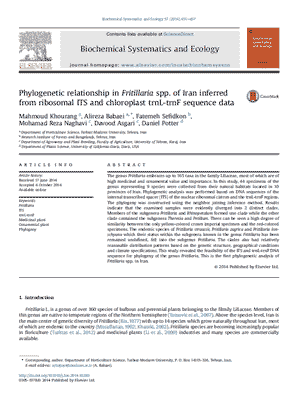NEWS 2014
Phylogenetic relationship in Fritillaria spp. of Iran inferred from ribosomal ITS and chloroplast trnL-trnF sequence data
Mahmoud KHOURANG¹, Alireza BABAEI¹, Fatemeh SEFIDKON², Mohamad Reza NAGHAVI³, Davood ASGARI³, Daniel POTTER⁴
Biochemical Systematics and Ecology 57: 451–457(2014)
doi: 10.1016/j.bse.2014.10.001
¹Department of Horticulture Science, Tarbiat Modares University, Tehran, Iran
²Research Institute of Forests and Rangelands, Tehran, Iran
³Department of Agronomy and Plant Breeding, Faculty of Agriculture, University of Tehran, Karaj, Iran
⁴Department of Plants Science, University of California-Davis, Davis, USA
Abstract
The genus Fritillaria embraces up to 165 taxa in the family Liliaceae, most of which are of high medicinal and ornamental value and importance. In this study, 44 specimens of the genus representing 9 species were collected from their natural habitats located in 10 provinces of Iran. Phylogenetic analysis was performed based on DNA sequences of the internal transcribed spacer (ITS) of the nuclear ribosomal cistron and the trnL-trnF regions. The phylogeny was constructed using the neighbor joining inference method. Results indicate that the examined samples were evidently diverged into 2 distinct clades. Members of the subgenera Fritillaria and Rhinopetalum formed one clade while the other clade contained the subgenera Theresia and Petilium. There can be seen a high degree of similarity between the only yellow-colored crown imperial specimen and the red-colored specimens. The endemic species of Fritillaria straussii, Fritillaria zagrica and Fritillaria kotschyana which their status within the subgenera known in the genus Fritillaria has been remained undefined, fell into the subgenus Fritillaria. The clades also had relatively reasonable distribution patterns based on the genetic structure, geographical conditions and climate specifications. This study revealed the feasibility of the ITS and trnL-trnF DNA sequence for phylogeny of the genus Fritillaria. This is the first phylogenetic analysis of Fritillaria spp. in Iran.

